-
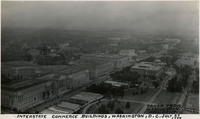 McCarthy Album 11, Photograph 188
McCarthy Album 11, Photograph 188 Caption: "Interstate Commerce Buildings, Washington, D.C. July 27, 1934, Taken from Washington Monument." Bird's eye view of the Department of Labor Building complex (which also included the offices of the Interstate Commerce Commission), constructed between 1932-1934.
-
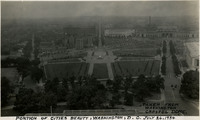 McCarthy Album 11, Photograph 187
McCarthy Album 11, Photograph 187 Caption: "Portion of Cities [sic] Beauty, Washington, D.C. July 26, 1934, Taken from Washington Capitol Dome." Bird's eye view of a portion of Washington, D.C., showing Upper and Lower Senate Parks.
-
 McCarthy Album 11, Photograph 186
McCarthy Album 11, Photograph 186 Caption: "Congressional Library, Washington, D.C. July 25, 1934. Taken from Washington Capitol Dome." A view of the Library of Congress. The Beaux Arts-style building was constructed between 1888 and 1894. It serves as the national library of the U.S., as well as the research library for the U.S. Congress.
-
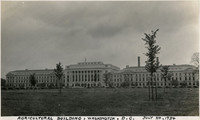 McCarthy Album 11, Photograph 185
McCarthy Album 11, Photograph 185 Caption: "Agricultural Building, Washington, D.C. July 24, 1934." The Administration Building for the U.S. Department of Agriculture, also called the Jamie L. Whitten Building, sprawls across this photograph. The enormous Beaux-Arts style building, designed by Rankin, Kellogg, and Crane, was constructed between 1903 and 1930.
-
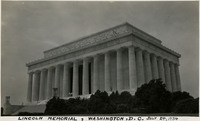 McCarthy Album 11, Photograph 184
McCarthy Album 11, Photograph 184 Caption: "Lincoln Memorial, Washington, D.C. July 24, 1934." View of the Lincoln Memorial's façade. The memorial's outer structure, styled after a Greek Doric temple, was designed by architect Henry Bacon, while the statue of Abraham Lincoln within was designed by Daniel Chester French. The memorial was dedicated in 1922.
-
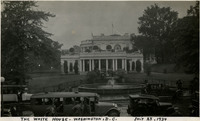 McCarthy Album 11, Photograph 183
McCarthy Album 11, Photograph 183 Caption: "The White House. Washington, D.C. July 23, 1934." East Wing of the White House in Washington, D.C. The Neoclassical-style residence and work place of the United States President, designed by James Hoban, was constructed between 1792 and 1800. See also 96-07-08-alb04-085 and 96-07-08-alb09-222.
-
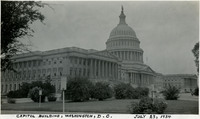 McCarthy Album 11, Photograph 182
McCarthy Album 11, Photograph 182 Caption: "Capitol Building, Washington, D. C. July 23, 1934." View of the domed United States Capitol, housing both the Senate and House of Representatives. Constructed between 1793 and 1800 and designed by architect William Thornton, the building has undergone several expansions, including the addition of the wedding-cake-style dome in the 1850s.
-
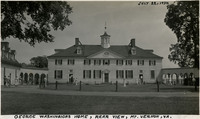 McCarthy Album 11, Photograph 181
McCarthy Album 11, Photograph 181 Caption: "George Washingions [sic] Home, Rear View, Mt. Vernon, Va. July 22, 1934." Rear view of Mount Vernon, the plantation home of George and Martha Washington. Built between 1758 and 1778, the Palladian-style mansion is now owned in trust by the Mount Vernon Ladies' Association and open to the public.
-
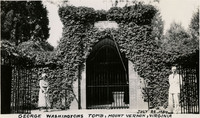 McCarthy Album 11, Photograph 180
McCarthy Album 11, Photograph 180 Caption: "George Washingtons [sic] Tomb, Mount Vernon, Virginia, July 22, 1934." The gated entrance to the tomb holding the remains of George Washington are seen in this photograph, overgrown by ivy. Two unidentified people stand at either side of the entry. The brick tomb was constructed after Washington's death in 1799.
-
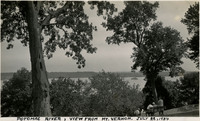 McCarthy Album 11, Photograph 179
McCarthy Album 11, Photograph 179 Caption: "Potomac River, View from Mt. Vernon. July 22, 1934." Trees obscure much of the photograph, but the Potomac River can be glimpsed in the distance.
-
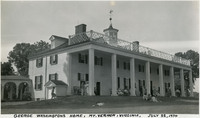 McCarthy Album 11, Photograph 178
McCarthy Album 11, Photograph 178 Caption: "George Washingtons [sic] Home, Mt. Vernon, Virginia. July 22, 1934." View of Mount Vernon, the plantation home of George and Martha Washington. Built between 1758 and 1778, the Palladian-style mansion is now owned in trust by the Mount Vernon Ladies' Association and open to the public.
-
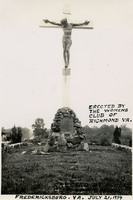 McCarthy Album 11, Photograph 177
McCarthy Album 11, Photograph 177 Caption: "Erected by the Women's Club of Richmond Va. Fredericksburg. VA. July 21, 1934." View of the Aquia Crucifix Monument in Virginia's Stafford County. Erected in 1930, the monument consists of a crucifix atop a stone marker with a plaque.
-
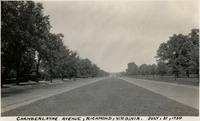 McCarthy Album 11, Photograph 176
McCarthy Album 11, Photograph 176 Caption: "Chamberlayne Avenue, Richmond, Virginia. July, [sic] 21, 1934." View of a wide thoroughfare, with a grass median, lined by trees.
-
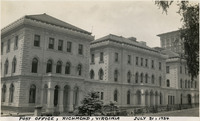 McCarthy Album 11, Photograph 175
McCarthy Album 11, Photograph 175 Caption: "Post Office, Richmond, Virginia, July 21, 1934." View of the Richmond Custom House and Post Office. The Custom House, the first federal building in Richmond, was designed by Ammi Burnham Young in 1858. The post office was located on the first floor (for easy access by citizens), the custom house occupied the second floor, and the third floor held a federal courtroom. The building was expanded between 1887 and 1889 to include two short wings on either side of the facade. A story was added to the building in 1910, and wings added in 1910 and 1930, so that now the building occupies the entire block.
-
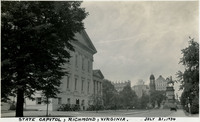 McCarthy Album 11, Photograph 174
McCarthy Album 11, Photograph 174 Caption: "State Capitol, Richmond, Virginia. July 21, 1934." Virginia's State Capitol is visible in the left side of this photograph, while the Virginia Washington Monument can be seen at the right. The Capitol, designed largely by Thomas Jefferson and French architect Charles-Louis Clérisseau, was sufficiently complete by October 1792 for the Virginia General Assembly to meet within its walls. The building served as the capitol of the Confederacy during the Civil War. The Virginia Washington Monument, completed in 1869, features a 21-foot-tall statue of George Washington, mounted on a horse.
-
 McCarthy Album 11, Photograph 173
McCarthy Album 11, Photograph 173 Caption: "Jefferson Davis Highway. U.S. No. 1. Virginia. July 20, 34." Grace McCarthy is standing next to a U.S. Route 1 sign along a highway in Virginia. The Jefferson Davis Highway project was begun by the United Daughters of the Confederacy (UDC). As auto tourism increased across the U.S., so to did the need for roads on which to drive. Private interests such as the UDC began to develop routes across the country, but with no central administrating organization the routes were haphazard and confusing. The UDC planned a route that was to stretch from Virginia across the southern U.S. to San Diego, but the entire route never materialized. The federal government stepped in to impose a numbering system on various routes across the nation. That portion of the planned Jefferson Davis Highway through Virginia was numbered as U.S. Route 1.
-
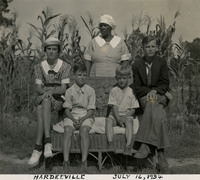 McCarthy Album 11, Photograph 172
McCarthy Album 11, Photograph 172 Caption: "Hardeeville, July 16, 1934." Four unidentified white children posing with an unidentified African-American woman, possibly their nanny given the manner of dress of all parties.
-
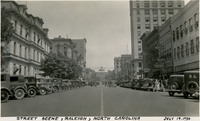 McCarthy Album 11, Photograph 171
McCarthy Album 11, Photograph 171 Caption: "Street Scene, Raleigh, North Carolina, July 19, 1934." Busy street in Raleigh, lined with parked cars. The dome and columned entryway of North Carolina's Capitol can be seen in the distance.
-
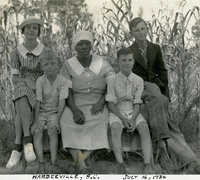 McCarthy Album 11, Photograph 170
McCarthy Album 11, Photograph 170 Caption: "Hardeeville, S.C. July 16, 1934." Four unidentified white children posing with an unidentified African-American woman, possibly their nanny, given the manner of dress of all parties.
-
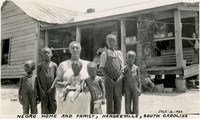 McCarthy Album 11, Photograph 169
McCarthy Album 11, Photograph 169 Caption: "Negro Home and Family, Hardeeville, South Carolina, July 16, 1934." Unidentified woman posing with several children in front of a small home. Another woman can be glimpsed seated on the porch of the home in the background.
-
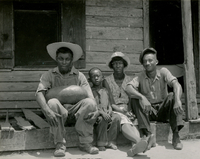 McCarthy Album 11, Photograph 168
McCarthy Album 11, Photograph 168 Two men, a woman, and a child, all unidentified, posing on a porch in Hardeeville. *PLEASE NOTE:* Original caption removed due to sensitive content. To view the original photograph with caption, please contact the California State Archives Reference Desk
-
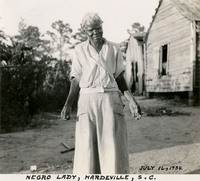 McCarthy Album 11, Photograph 167
McCarthy Album 11, Photograph 167 Caption: "Negro Lady, Hardeville [sic], S.C. July 16, 1934." Unidentified woman posing in front of a dilapidated home.
-
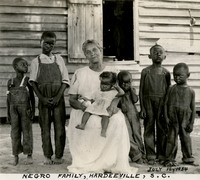 McCarthy Album 11, Photograph 166
McCarthy Album 11, Photograph 166 Caption: "Negro Family, Hardeeville, S.C. July 16, 1934." Unidentified woman posing with several children.
-
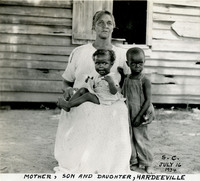 McCarthy Album 11, Photograph 165
McCarthy Album 11, Photograph 165 Caption: "Mother, Son and Daughter, Hardeeville, S.C., July 16, 1934." Unidentified woman posing with two small children.
-
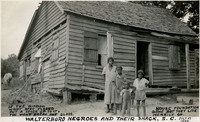 McCarthy Album 11, Photograph 164
McCarthy Album 11, Photograph 164 Caption: "Walterboro Negroes and Their Shack. If the Window Wont [sic] Stay Closed, Put a Stick Up to It, You Wont [sic] Break the Glass. House Foundation Gone But They Live Merrily On. July 17, 1934." Unidentified family posing in front of a dilapidated home in Walterboro.
-
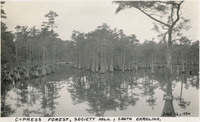 McCarthy Album 11, Photograph 163
McCarthy Album 11, Photograph 163 Caption: "Cypress Forest, Society Hill, South Carolina. July 16, 1934." A grove of cypress trees near the town of Society Hill.
-
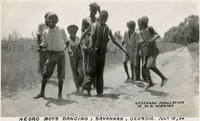 McCarthy Album 11, Photograph 162
McCarthy Album 11, Photograph 162 Caption: "Negro Boys Dancing, Savannah, Georgia. Savannah Population is 50% Negroes, July 15, 34." A group of young boys of various ages show off their dancing skills along a country road. According to census information available online, the population of Savannah in 1930 consisted of 54.2% white, 45.7% black.
-
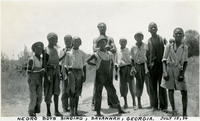 McCarthy Album 11, Photograph 161
McCarthy Album 11, Photograph 161 Caption: "Negro Boys Singing, Savannah, Georgia. July 15, 34." A group of young boys of various ages pose for a photograph along a country road.
-
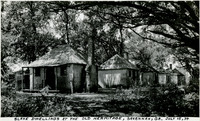 McCarthy Album 11, Photograph 160
McCarthy Album 11, Photograph 160 Caption: "Slave Dwellings at the Old Hermitage, Savannah, Ga. July 15, 1934." A row of small brick houses surrounded by trees. The Old Hermitage was a 400-acre plantation on the Savannah River, owned by Henry McAlpin. McAlpin not only conducted farming operations at the plantation, but also manufactured bricks, barrels, cast iron products, and lumber. For that reason, he built the slave quarters for the plantation from brick, rather than wood as was common for most other plantations in the South.
-
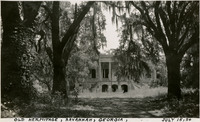 McCarthy Album 11, Photograph 159
McCarthy Album 11, Photograph 159 Caption: "Old Hermitage, Savannah, Georgia, July 15, 1934." The remains of the Hermitage Plantation mansion, built in 1830, can be seen through trees draped with Spanish moss. Hermitage was a 400-acre plantation on the Savannah River, owned by Henry McAlpin. McAlpin not only conducted farming operations at the planation, but also manufactured bricks, barrels, cast iron products, and lumber.
-
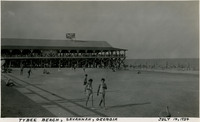 McCarthy Album 11, Photograph 158
McCarthy Album 11, Photograph 158 Caption: "Tybee Beach, Savannah, Georgia, July 14, 1934." Beach scene with a small crowd of unidentified people enjoying the ocean waves and strolling in the sand. The large Tybrisa Pavilion, set on a wood pier, extends into the water. Tybee Beach is one of several beaches in Tybee Island, a town on an island of the same name located across the river from Savannah. The island became a popular tourist spot between the Civil War and the mid-twentieth century, particularly after the Central of Georgia Railway constructed a line to the island. To encourage tourists, the railroad built Tybrisa Pavilion in 1891. It featured a large dance floor that became popular on the Big Band circuit, but was destroyed by fire in 1967.
-
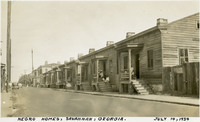 McCarthy Album 11, Photograph 157
McCarthy Album 11, Photograph 157 Caption: "Negro Homes, Savannah, Georgia. July 14, 1934." Row of identical small homes set closely together, each with a small front porch. Several unidentified people can be seen on a few of the porches.
-
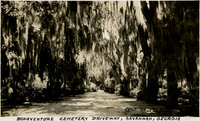 McCarthy Album 11, Photograph 156
McCarthy Album 11, Photograph 156 Caption: "Bonaventure Cemetery Driveway, Savannah, Georgia, July 14, 1934." Road stretching into the distance, flanked by trees dripping with Spanish moss. The Bonaventure Cemetery in Savannah originated in a private cemetery on a plantation. The plantation was sold in 1846. Major William H. Wiltberger, son of the new owner, formed the Evergreen Cemetery Company in 1868. The City of Savannah purchased the company and cemetery in 1907, and changed its name to Bonaventure Cemetery.
-
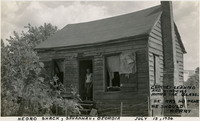 McCarthy Album 11, Photograph 155
McCarthy Album 11, Photograph 155 Caption: "Negro Shack, Savannah, Georgia, Chimney Leaning and Windows Minus the Glass. He has No Pane. He Should Worry, July 13, 1934." View of a small home, with a leaning chimney on one side. An unidentified man stands in the doorway.
-
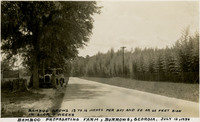 McCarthy Album 11, Photograph 154
McCarthy Album 11, Photograph 154 Caption: "Bamboo Grows 12 to 16 Inches Per Day and 50 or 60 Feet High in 6 or 7 Weeks. Bamboo Propagating Farm, Burrows, Georgia. July 13, 1934." Grace McCarthy stands next to an automobile on the side of a road under trees. The other side of the road is flanked by rows of bamboo plants. This may be part of the U.S. Department of Agriculture's Savannah Plant Introduction Station, established in approximately 1919 in the Burroughs Station area southwest of Savannah. The station remained open until 1979, when it was closed by USDA budgetary downsizing. The property was subsequently deeded to the University of Georgia, in 1983.
-
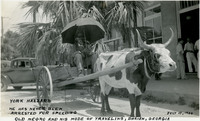 McCarthy Album 11, Photograph 153
McCarthy Album 11, Photograph 153 Caption: "York Hazzard. He has Never Been Arrested for Speeding. Old Negro and His Mode of Traveling, Darien, Ga. July 13, 1934." York Hazzard, an elderly man of African-American ethnicity, seated in a small wooden cart drawn by a cow or steer. In this photograph Hazzard is sheltered from the sun by an umbrella. An automobile is parked on the street behind the cart.
-
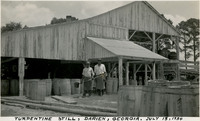 McCarthy Album 11, Photograph 152
McCarthy Album 11, Photograph 152 Caption: "Turpentine Still, Darien, Georgia. July 13, 1934." Two unidentified men standing in front of a large barn or shed, with numerous barrels surrounding them, presumably for turpentine and other resin products. After being harvested from pine trees, resin is then subjected to steam distillation to evaporate off the turpentine.
-
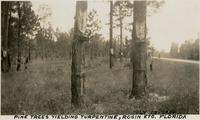 McCarthy Album 11, Photograph 151
McCarthy Album 11, Photograph 151 Caption: "Pine Trees Yielding Turpentine, Rosin [sic], Etc. Florida, July 13, 1934." A group of pine trees with bark removed in a "V"-shaped, or "catface" pattern to encourage production of resin, from which turpentine is made. Small buckets hang at the end of each "V" to catch the resin. This turpentine farm may actually be in Georgia, rather than Florida.
-
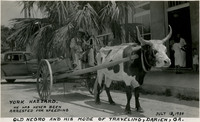 McCarthy Album 11, Photograph 150
McCarthy Album 11, Photograph 150 Caption: "York Hazzard. He has Never Been Arrested for Speeding. Old Negro and His Mode of Traveling, Darien, Ga. July 13, 1934." York Hazzard, an elderly man of African-American ethnicity, seated in a small wooden cart drawn by a cow or steer. An automobile is parked on the street behind the cart.
-
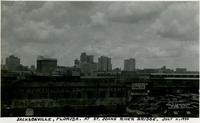 McCarthy Album 11, Photograph 149
McCarthy Album 11, Photograph 149 Caption: "Jacksonville, Florida. At St. John's River Bridge. July 11, 1934." View of Jacksonville's skyline.
-
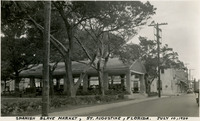 McCarthy Album 11, Photograph 148
McCarthy Album 11, Photograph 148 Caption: "Spanish Slave Market, St. Augustine, Florida. July 10, 1934." An open-air pavilion with a gabled roof and six bays appears in the center of this photograph, somewhat obscured by surrounding trees and vegetation. The waterfront site on which the pavilion sits has served St. Augustine as a marketplace since the city's founding in the sixteenth century, for food, commercial goods, and for slaves. The pavilion in the photograph was constructed in 1888, after a fire burned down the previous structure. In the twentieth century, entrepreneurs used the slave market aspect of the site's history as a hook to entice northern tourists into St. Augustine's historic quarter. The market has often served as a rallying site for protestors, from suffragettes to protestors of the war in Iraq. Various civil rights marches held around the market in the 1960s attracted such luminaries as Dr. Martin Luther King, Jr. and Andrew Young.
-
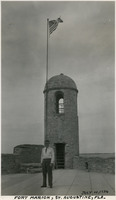 McCarthy Album 11, Photograph 147
McCarthy Album 11, Photograph 147 Caption: "Fort Marion, St. Augustine, Fla. July 10, 1934." William McCarthy standing in front of a corner tower on the ramparts of Castillo de San Marcos (Castle of Saint Mark). The core structures of this coastal defense fort were completed by Spanish forces in 1695. Numerous additions, renovations, and repairs have occurred since that time. When Spain ceded Florida to the U.S. in 1821, the Castillo was designated a U.S. Army base and renamed Fort Marion, in honor of Frances Marion (also known as the Swamp Fox, Marion was an American Revolutionary War hero known for his guerilla war tactics). The fort was deactivated in 1933, and turned over to the National Park Service.
-
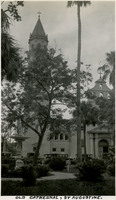 McCarthy Album 11, Photograph 146
McCarthy Album 11, Photograph 146 Caption: "Old Cathedral, St. Augustine." View of the tower, columned entryway, and bells of Cathedral Basilica of St. Augustine. The oldest church in Florida, the first building on the site was established in 1565. The cathedral seen in this photograph (which exists today) was constructed between 1793 and 1797. The cathedral was designated a National Historic Landmark in 1970.
-
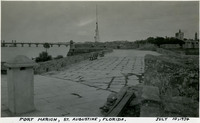 McCarthy Album 11, Photograph 145
McCarthy Album 11, Photograph 145 Caption: "Fort Marion, St. Augustine, Florida. July 10, 1934." Walkway atop what appears to be the ramparts of the Castillo de San Marcos (Castle of Saint Mark). The core structures of this coastal defense fort were completed by Spanish forces in 1695. Numerous additions, renovations, and repairs have occurred since that time. When Spain ceded Florida to the U.S. in 1821, the Castillo was designated a U.S. Army base and renamed Fort Marion, in honor of Frances Marion (also known as the Swamp Fox, Marion was an American Revolutionary War hero known for his guerilla war tactics). The fort was deactivated in 1933, and turned over to the National Park Service.
-
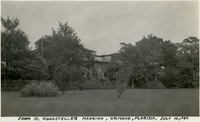 McCarthy Album 11, Photograph 144
McCarthy Album 11, Photograph 144 Caption: "John D. Rockefeller Mansion, Ormond [sic], Florida. July 10, 1934." A large mansion can be glimpsed through surrounding trees and other vegetation in this photograph. The mansion is known as the Casements, for the numerous casement windows incorporated into its structure. Built in 1914 in Ormond Beach, John D. Rockefeller purchased the home in 1918 for use as a winter residence. After Rockefeller died in 1937, the property was sold several times, until the City of Ormond Beach bought it in 1973. The city renovated it for use as a cultural and community center, a purpose which it still serves.
-
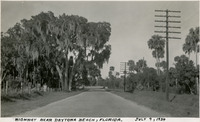 McCarthy Album 11, Photograph 143
McCarthy Album 11, Photograph 143 Caption: "Highway Near Daytona Beach, Florida. July 9, 1934." A road stretches toward a curve in the distance, flanked by trees dripping with Spanish moss, and palm trees.
-
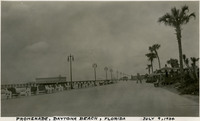 McCarthy Album 11, Photograph 142
McCarthy Album 11, Photograph 142 Caption: "Promenade, Daytona Beach, Florida, July 9, 1934." Wide promenade along the beach at Daytona Beach, featuring a row of benches at the left (seaside) and covered seating areas on the right, with palm trees. Daytona Beach was created when the neighboring towns of Daytona, Daytona Beach, Kingston, and Seabreeze merged in 1926. The area's beach was already well-known in both tourist and automobile circles
-
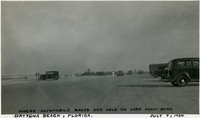 McCarthy Album 11, Photograph 141
McCarthy Album 11, Photograph 141 Caption: "Where Automobile Races are Held on Hard Sandy Beach, Daytona Beach, Florida. July 9, 1934." This photograph illustrates the wide, hard-packed sands of the beach at Daytona Beach, used by early motorists as a race track and testing ground for new vehicles. Bathers enjoy the surf to the left, while many automobiles are visible in the rest of the photograph.
-
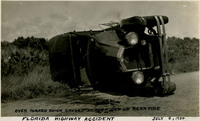 McCarthy Album 11, Photograph 140
McCarthy Album 11, Photograph 140 Caption: "Over Turned Buick Caused by Blow Out on Rear Tire, Florida Highway Accident, July 8, 1934." An automobile lying on its side after having blown out a rear tire on a Florida highway.
-
 McCarthy Album 11, Photograph 139
McCarthy Album 11, Photograph 139 Caption: "Lake View Avenue Bridge, Palm Beach, Florida. July 8, 1934." View of the Royal Park Bridge, a bascule bridge constructed in the 1920s. This bridge has since been replaced with a more modern structure.
 McCarthy Album 11, Photograph 188 Caption: "Interstate Commerce Buildings, Washington, D.C. July 27, 1934, Taken from Washington Monument." Bird's eye view of the Department of Labor Building complex (which also included the offices of the Interstate Commerce Commission), constructed between 1932-1934.
McCarthy Album 11, Photograph 188 Caption: "Interstate Commerce Buildings, Washington, D.C. July 27, 1934, Taken from Washington Monument." Bird's eye view of the Department of Labor Building complex (which also included the offices of the Interstate Commerce Commission), constructed between 1932-1934. McCarthy Album 11, Photograph 187 Caption: "Portion of Cities [sic] Beauty, Washington, D.C. July 26, 1934, Taken from Washington Capitol Dome." Bird's eye view of a portion of Washington, D.C., showing Upper and Lower Senate Parks.
McCarthy Album 11, Photograph 187 Caption: "Portion of Cities [sic] Beauty, Washington, D.C. July 26, 1934, Taken from Washington Capitol Dome." Bird's eye view of a portion of Washington, D.C., showing Upper and Lower Senate Parks. McCarthy Album 11, Photograph 186 Caption: "Congressional Library, Washington, D.C. July 25, 1934. Taken from Washington Capitol Dome." A view of the Library of Congress. The Beaux Arts-style building was constructed between 1888 and 1894. It serves as the national library of the U.S., as well as the research library for the U.S. Congress.
McCarthy Album 11, Photograph 186 Caption: "Congressional Library, Washington, D.C. July 25, 1934. Taken from Washington Capitol Dome." A view of the Library of Congress. The Beaux Arts-style building was constructed between 1888 and 1894. It serves as the national library of the U.S., as well as the research library for the U.S. Congress. McCarthy Album 11, Photograph 185 Caption: "Agricultural Building, Washington, D.C. July 24, 1934." The Administration Building for the U.S. Department of Agriculture, also called the Jamie L. Whitten Building, sprawls across this photograph. The enormous Beaux-Arts style building, designed by Rankin, Kellogg, and Crane, was constructed between 1903 and 1930.
McCarthy Album 11, Photograph 185 Caption: "Agricultural Building, Washington, D.C. July 24, 1934." The Administration Building for the U.S. Department of Agriculture, also called the Jamie L. Whitten Building, sprawls across this photograph. The enormous Beaux-Arts style building, designed by Rankin, Kellogg, and Crane, was constructed between 1903 and 1930. McCarthy Album 11, Photograph 184 Caption: "Lincoln Memorial, Washington, D.C. July 24, 1934." View of the Lincoln Memorial's façade. The memorial's outer structure, styled after a Greek Doric temple, was designed by architect Henry Bacon, while the statue of Abraham Lincoln within was designed by Daniel Chester French. The memorial was dedicated in 1922.
McCarthy Album 11, Photograph 184 Caption: "Lincoln Memorial, Washington, D.C. July 24, 1934." View of the Lincoln Memorial's façade. The memorial's outer structure, styled after a Greek Doric temple, was designed by architect Henry Bacon, while the statue of Abraham Lincoln within was designed by Daniel Chester French. The memorial was dedicated in 1922. McCarthy Album 11, Photograph 183 Caption: "The White House. Washington, D.C. July 23, 1934." East Wing of the White House in Washington, D.C. The Neoclassical-style residence and work place of the United States President, designed by James Hoban, was constructed between 1792 and 1800. See also 96-07-08-alb04-085 and 96-07-08-alb09-222.
McCarthy Album 11, Photograph 183 Caption: "The White House. Washington, D.C. July 23, 1934." East Wing of the White House in Washington, D.C. The Neoclassical-style residence and work place of the United States President, designed by James Hoban, was constructed between 1792 and 1800. See also 96-07-08-alb04-085 and 96-07-08-alb09-222. McCarthy Album 11, Photograph 182 Caption: "Capitol Building, Washington, D. C. July 23, 1934." View of the domed United States Capitol, housing both the Senate and House of Representatives. Constructed between 1793 and 1800 and designed by architect William Thornton, the building has undergone several expansions, including the addition of the wedding-cake-style dome in the 1850s.
McCarthy Album 11, Photograph 182 Caption: "Capitol Building, Washington, D. C. July 23, 1934." View of the domed United States Capitol, housing both the Senate and House of Representatives. Constructed between 1793 and 1800 and designed by architect William Thornton, the building has undergone several expansions, including the addition of the wedding-cake-style dome in the 1850s. McCarthy Album 11, Photograph 181 Caption: "George Washingions [sic] Home, Rear View, Mt. Vernon, Va. July 22, 1934." Rear view of Mount Vernon, the plantation home of George and Martha Washington. Built between 1758 and 1778, the Palladian-style mansion is now owned in trust by the Mount Vernon Ladies' Association and open to the public.
McCarthy Album 11, Photograph 181 Caption: "George Washingions [sic] Home, Rear View, Mt. Vernon, Va. July 22, 1934." Rear view of Mount Vernon, the plantation home of George and Martha Washington. Built between 1758 and 1778, the Palladian-style mansion is now owned in trust by the Mount Vernon Ladies' Association and open to the public. McCarthy Album 11, Photograph 180 Caption: "George Washingtons [sic] Tomb, Mount Vernon, Virginia, July 22, 1934." The gated entrance to the tomb holding the remains of George Washington are seen in this photograph, overgrown by ivy. Two unidentified people stand at either side of the entry. The brick tomb was constructed after Washington's death in 1799.
McCarthy Album 11, Photograph 180 Caption: "George Washingtons [sic] Tomb, Mount Vernon, Virginia, July 22, 1934." The gated entrance to the tomb holding the remains of George Washington are seen in this photograph, overgrown by ivy. Two unidentified people stand at either side of the entry. The brick tomb was constructed after Washington's death in 1799. McCarthy Album 11, Photograph 179 Caption: "Potomac River, View from Mt. Vernon. July 22, 1934." Trees obscure much of the photograph, but the Potomac River can be glimpsed in the distance.
McCarthy Album 11, Photograph 179 Caption: "Potomac River, View from Mt. Vernon. July 22, 1934." Trees obscure much of the photograph, but the Potomac River can be glimpsed in the distance. McCarthy Album 11, Photograph 178 Caption: "George Washingtons [sic] Home, Mt. Vernon, Virginia. July 22, 1934." View of Mount Vernon, the plantation home of George and Martha Washington. Built between 1758 and 1778, the Palladian-style mansion is now owned in trust by the Mount Vernon Ladies' Association and open to the public.
McCarthy Album 11, Photograph 178 Caption: "George Washingtons [sic] Home, Mt. Vernon, Virginia. July 22, 1934." View of Mount Vernon, the plantation home of George and Martha Washington. Built between 1758 and 1778, the Palladian-style mansion is now owned in trust by the Mount Vernon Ladies' Association and open to the public. McCarthy Album 11, Photograph 177 Caption: "Erected by the Women's Club of Richmond Va. Fredericksburg. VA. July 21, 1934." View of the Aquia Crucifix Monument in Virginia's Stafford County. Erected in 1930, the monument consists of a crucifix atop a stone marker with a plaque.
McCarthy Album 11, Photograph 177 Caption: "Erected by the Women's Club of Richmond Va. Fredericksburg. VA. July 21, 1934." View of the Aquia Crucifix Monument in Virginia's Stafford County. Erected in 1930, the monument consists of a crucifix atop a stone marker with a plaque. McCarthy Album 11, Photograph 176 Caption: "Chamberlayne Avenue, Richmond, Virginia. July, [sic] 21, 1934." View of a wide thoroughfare, with a grass median, lined by trees.
McCarthy Album 11, Photograph 176 Caption: "Chamberlayne Avenue, Richmond, Virginia. July, [sic] 21, 1934." View of a wide thoroughfare, with a grass median, lined by trees. McCarthy Album 11, Photograph 175 Caption: "Post Office, Richmond, Virginia, July 21, 1934." View of the Richmond Custom House and Post Office. The Custom House, the first federal building in Richmond, was designed by Ammi Burnham Young in 1858. The post office was located on the first floor (for easy access by citizens), the custom house occupied the second floor, and the third floor held a federal courtroom. The building was expanded between 1887 and 1889 to include two short wings on either side of the facade. A story was added to the building in 1910, and wings added in 1910 and 1930, so that now the building occupies the entire block.
McCarthy Album 11, Photograph 175 Caption: "Post Office, Richmond, Virginia, July 21, 1934." View of the Richmond Custom House and Post Office. The Custom House, the first federal building in Richmond, was designed by Ammi Burnham Young in 1858. The post office was located on the first floor (for easy access by citizens), the custom house occupied the second floor, and the third floor held a federal courtroom. The building was expanded between 1887 and 1889 to include two short wings on either side of the facade. A story was added to the building in 1910, and wings added in 1910 and 1930, so that now the building occupies the entire block. McCarthy Album 11, Photograph 174 Caption: "State Capitol, Richmond, Virginia. July 21, 1934." Virginia's State Capitol is visible in the left side of this photograph, while the Virginia Washington Monument can be seen at the right. The Capitol, designed largely by Thomas Jefferson and French architect Charles-Louis Clérisseau, was sufficiently complete by October 1792 for the Virginia General Assembly to meet within its walls. The building served as the capitol of the Confederacy during the Civil War. The Virginia Washington Monument, completed in 1869, features a 21-foot-tall statue of George Washington, mounted on a horse.
McCarthy Album 11, Photograph 174 Caption: "State Capitol, Richmond, Virginia. July 21, 1934." Virginia's State Capitol is visible in the left side of this photograph, while the Virginia Washington Monument can be seen at the right. The Capitol, designed largely by Thomas Jefferson and French architect Charles-Louis Clérisseau, was sufficiently complete by October 1792 for the Virginia General Assembly to meet within its walls. The building served as the capitol of the Confederacy during the Civil War. The Virginia Washington Monument, completed in 1869, features a 21-foot-tall statue of George Washington, mounted on a horse. McCarthy Album 11, Photograph 173 Caption: "Jefferson Davis Highway. U.S. No. 1. Virginia. July 20, 34." Grace McCarthy is standing next to a U.S. Route 1 sign along a highway in Virginia. The Jefferson Davis Highway project was begun by the United Daughters of the Confederacy (UDC). As auto tourism increased across the U.S., so to did the need for roads on which to drive. Private interests such as the UDC began to develop routes across the country, but with no central administrating organization the routes were haphazard and confusing. The UDC planned a route that was to stretch from Virginia across the southern U.S. to San Diego, but the entire route never materialized. The federal government stepped in to impose a numbering system on various routes across the nation. That portion of the planned Jefferson Davis Highway through Virginia was numbered as U.S. Route 1.
McCarthy Album 11, Photograph 173 Caption: "Jefferson Davis Highway. U.S. No. 1. Virginia. July 20, 34." Grace McCarthy is standing next to a U.S. Route 1 sign along a highway in Virginia. The Jefferson Davis Highway project was begun by the United Daughters of the Confederacy (UDC). As auto tourism increased across the U.S., so to did the need for roads on which to drive. Private interests such as the UDC began to develop routes across the country, but with no central administrating organization the routes were haphazard and confusing. The UDC planned a route that was to stretch from Virginia across the southern U.S. to San Diego, but the entire route never materialized. The federal government stepped in to impose a numbering system on various routes across the nation. That portion of the planned Jefferson Davis Highway through Virginia was numbered as U.S. Route 1. McCarthy Album 11, Photograph 172 Caption: "Hardeeville, July 16, 1934." Four unidentified white children posing with an unidentified African-American woman, possibly their nanny given the manner of dress of all parties.
McCarthy Album 11, Photograph 172 Caption: "Hardeeville, July 16, 1934." Four unidentified white children posing with an unidentified African-American woman, possibly their nanny given the manner of dress of all parties. McCarthy Album 11, Photograph 171 Caption: "Street Scene, Raleigh, North Carolina, July 19, 1934." Busy street in Raleigh, lined with parked cars. The dome and columned entryway of North Carolina's Capitol can be seen in the distance.
McCarthy Album 11, Photograph 171 Caption: "Street Scene, Raleigh, North Carolina, July 19, 1934." Busy street in Raleigh, lined with parked cars. The dome and columned entryway of North Carolina's Capitol can be seen in the distance. McCarthy Album 11, Photograph 170 Caption: "Hardeeville, S.C. July 16, 1934." Four unidentified white children posing with an unidentified African-American woman, possibly their nanny, given the manner of dress of all parties.
McCarthy Album 11, Photograph 170 Caption: "Hardeeville, S.C. July 16, 1934." Four unidentified white children posing with an unidentified African-American woman, possibly their nanny, given the manner of dress of all parties. McCarthy Album 11, Photograph 169 Caption: "Negro Home and Family, Hardeeville, South Carolina, July 16, 1934." Unidentified woman posing with several children in front of a small home. Another woman can be glimpsed seated on the porch of the home in the background.
McCarthy Album 11, Photograph 169 Caption: "Negro Home and Family, Hardeeville, South Carolina, July 16, 1934." Unidentified woman posing with several children in front of a small home. Another woman can be glimpsed seated on the porch of the home in the background. McCarthy Album 11, Photograph 168 Two men, a woman, and a child, all unidentified, posing on a porch in Hardeeville. *PLEASE NOTE:* Original caption removed due to sensitive content. To view the original photograph with caption, please contact the California State Archives Reference Desk
McCarthy Album 11, Photograph 168 Two men, a woman, and a child, all unidentified, posing on a porch in Hardeeville. *PLEASE NOTE:* Original caption removed due to sensitive content. To view the original photograph with caption, please contact the California State Archives Reference Desk McCarthy Album 11, Photograph 167 Caption: "Negro Lady, Hardeville [sic], S.C. July 16, 1934." Unidentified woman posing in front of a dilapidated home.
McCarthy Album 11, Photograph 167 Caption: "Negro Lady, Hardeville [sic], S.C. July 16, 1934." Unidentified woman posing in front of a dilapidated home. McCarthy Album 11, Photograph 166 Caption: "Negro Family, Hardeeville, S.C. July 16, 1934." Unidentified woman posing with several children.
McCarthy Album 11, Photograph 166 Caption: "Negro Family, Hardeeville, S.C. July 16, 1934." Unidentified woman posing with several children. McCarthy Album 11, Photograph 165 Caption: "Mother, Son and Daughter, Hardeeville, S.C., July 16, 1934." Unidentified woman posing with two small children.
McCarthy Album 11, Photograph 165 Caption: "Mother, Son and Daughter, Hardeeville, S.C., July 16, 1934." Unidentified woman posing with two small children. McCarthy Album 11, Photograph 164 Caption: "Walterboro Negroes and Their Shack. If the Window Wont [sic] Stay Closed, Put a Stick Up to It, You Wont [sic] Break the Glass. House Foundation Gone But They Live Merrily On. July 17, 1934." Unidentified family posing in front of a dilapidated home in Walterboro.
McCarthy Album 11, Photograph 164 Caption: "Walterboro Negroes and Their Shack. If the Window Wont [sic] Stay Closed, Put a Stick Up to It, You Wont [sic] Break the Glass. House Foundation Gone But They Live Merrily On. July 17, 1934." Unidentified family posing in front of a dilapidated home in Walterboro. McCarthy Album 11, Photograph 163 Caption: "Cypress Forest, Society Hill, South Carolina. July 16, 1934." A grove of cypress trees near the town of Society Hill.
McCarthy Album 11, Photograph 163 Caption: "Cypress Forest, Society Hill, South Carolina. July 16, 1934." A grove of cypress trees near the town of Society Hill. McCarthy Album 11, Photograph 162 Caption: "Negro Boys Dancing, Savannah, Georgia. Savannah Population is 50% Negroes, July 15, 34." A group of young boys of various ages show off their dancing skills along a country road. According to census information available online, the population of Savannah in 1930 consisted of 54.2% white, 45.7% black.
McCarthy Album 11, Photograph 162 Caption: "Negro Boys Dancing, Savannah, Georgia. Savannah Population is 50% Negroes, July 15, 34." A group of young boys of various ages show off their dancing skills along a country road. According to census information available online, the population of Savannah in 1930 consisted of 54.2% white, 45.7% black. McCarthy Album 11, Photograph 161 Caption: "Negro Boys Singing, Savannah, Georgia. July 15, 34." A group of young boys of various ages pose for a photograph along a country road.
McCarthy Album 11, Photograph 161 Caption: "Negro Boys Singing, Savannah, Georgia. July 15, 34." A group of young boys of various ages pose for a photograph along a country road. McCarthy Album 11, Photograph 160 Caption: "Slave Dwellings at the Old Hermitage, Savannah, Ga. July 15, 1934." A row of small brick houses surrounded by trees. The Old Hermitage was a 400-acre plantation on the Savannah River, owned by Henry McAlpin. McAlpin not only conducted farming operations at the plantation, but also manufactured bricks, barrels, cast iron products, and lumber. For that reason, he built the slave quarters for the plantation from brick, rather than wood as was common for most other plantations in the South.
McCarthy Album 11, Photograph 160 Caption: "Slave Dwellings at the Old Hermitage, Savannah, Ga. July 15, 1934." A row of small brick houses surrounded by trees. The Old Hermitage was a 400-acre plantation on the Savannah River, owned by Henry McAlpin. McAlpin not only conducted farming operations at the plantation, but also manufactured bricks, barrels, cast iron products, and lumber. For that reason, he built the slave quarters for the plantation from brick, rather than wood as was common for most other plantations in the South. McCarthy Album 11, Photograph 159 Caption: "Old Hermitage, Savannah, Georgia, July 15, 1934." The remains of the Hermitage Plantation mansion, built in 1830, can be seen through trees draped with Spanish moss. Hermitage was a 400-acre plantation on the Savannah River, owned by Henry McAlpin. McAlpin not only conducted farming operations at the planation, but also manufactured bricks, barrels, cast iron products, and lumber.
McCarthy Album 11, Photograph 159 Caption: "Old Hermitage, Savannah, Georgia, July 15, 1934." The remains of the Hermitage Plantation mansion, built in 1830, can be seen through trees draped with Spanish moss. Hermitage was a 400-acre plantation on the Savannah River, owned by Henry McAlpin. McAlpin not only conducted farming operations at the planation, but also manufactured bricks, barrels, cast iron products, and lumber. McCarthy Album 11, Photograph 158 Caption: "Tybee Beach, Savannah, Georgia, July 14, 1934." Beach scene with a small crowd of unidentified people enjoying the ocean waves and strolling in the sand. The large Tybrisa Pavilion, set on a wood pier, extends into the water. Tybee Beach is one of several beaches in Tybee Island, a town on an island of the same name located across the river from Savannah. The island became a popular tourist spot between the Civil War and the mid-twentieth century, particularly after the Central of Georgia Railway constructed a line to the island. To encourage tourists, the railroad built Tybrisa Pavilion in 1891. It featured a large dance floor that became popular on the Big Band circuit, but was destroyed by fire in 1967.
McCarthy Album 11, Photograph 158 Caption: "Tybee Beach, Savannah, Georgia, July 14, 1934." Beach scene with a small crowd of unidentified people enjoying the ocean waves and strolling in the sand. The large Tybrisa Pavilion, set on a wood pier, extends into the water. Tybee Beach is one of several beaches in Tybee Island, a town on an island of the same name located across the river from Savannah. The island became a popular tourist spot between the Civil War and the mid-twentieth century, particularly after the Central of Georgia Railway constructed a line to the island. To encourage tourists, the railroad built Tybrisa Pavilion in 1891. It featured a large dance floor that became popular on the Big Band circuit, but was destroyed by fire in 1967. McCarthy Album 11, Photograph 157 Caption: "Negro Homes, Savannah, Georgia. July 14, 1934." Row of identical small homes set closely together, each with a small front porch. Several unidentified people can be seen on a few of the porches.
McCarthy Album 11, Photograph 157 Caption: "Negro Homes, Savannah, Georgia. July 14, 1934." Row of identical small homes set closely together, each with a small front porch. Several unidentified people can be seen on a few of the porches. McCarthy Album 11, Photograph 156 Caption: "Bonaventure Cemetery Driveway, Savannah, Georgia, July 14, 1934." Road stretching into the distance, flanked by trees dripping with Spanish moss. The Bonaventure Cemetery in Savannah originated in a private cemetery on a plantation. The plantation was sold in 1846. Major William H. Wiltberger, son of the new owner, formed the Evergreen Cemetery Company in 1868. The City of Savannah purchased the company and cemetery in 1907, and changed its name to Bonaventure Cemetery.
McCarthy Album 11, Photograph 156 Caption: "Bonaventure Cemetery Driveway, Savannah, Georgia, July 14, 1934." Road stretching into the distance, flanked by trees dripping with Spanish moss. The Bonaventure Cemetery in Savannah originated in a private cemetery on a plantation. The plantation was sold in 1846. Major William H. Wiltberger, son of the new owner, formed the Evergreen Cemetery Company in 1868. The City of Savannah purchased the company and cemetery in 1907, and changed its name to Bonaventure Cemetery. McCarthy Album 11, Photograph 155 Caption: "Negro Shack, Savannah, Georgia, Chimney Leaning and Windows Minus the Glass. He has No Pane. He Should Worry, July 13, 1934." View of a small home, with a leaning chimney on one side. An unidentified man stands in the doorway.
McCarthy Album 11, Photograph 155 Caption: "Negro Shack, Savannah, Georgia, Chimney Leaning and Windows Minus the Glass. He has No Pane. He Should Worry, July 13, 1934." View of a small home, with a leaning chimney on one side. An unidentified man stands in the doorway. McCarthy Album 11, Photograph 154 Caption: "Bamboo Grows 12 to 16 Inches Per Day and 50 or 60 Feet High in 6 or 7 Weeks. Bamboo Propagating Farm, Burrows, Georgia. July 13, 1934." Grace McCarthy stands next to an automobile on the side of a road under trees. The other side of the road is flanked by rows of bamboo plants. This may be part of the U.S. Department of Agriculture's Savannah Plant Introduction Station, established in approximately 1919 in the Burroughs Station area southwest of Savannah. The station remained open until 1979, when it was closed by USDA budgetary downsizing. The property was subsequently deeded to the University of Georgia, in 1983.
McCarthy Album 11, Photograph 154 Caption: "Bamboo Grows 12 to 16 Inches Per Day and 50 or 60 Feet High in 6 or 7 Weeks. Bamboo Propagating Farm, Burrows, Georgia. July 13, 1934." Grace McCarthy stands next to an automobile on the side of a road under trees. The other side of the road is flanked by rows of bamboo plants. This may be part of the U.S. Department of Agriculture's Savannah Plant Introduction Station, established in approximately 1919 in the Burroughs Station area southwest of Savannah. The station remained open until 1979, when it was closed by USDA budgetary downsizing. The property was subsequently deeded to the University of Georgia, in 1983. McCarthy Album 11, Photograph 153 Caption: "York Hazzard. He has Never Been Arrested for Speeding. Old Negro and His Mode of Traveling, Darien, Ga. July 13, 1934." York Hazzard, an elderly man of African-American ethnicity, seated in a small wooden cart drawn by a cow or steer. In this photograph Hazzard is sheltered from the sun by an umbrella. An automobile is parked on the street behind the cart.
McCarthy Album 11, Photograph 153 Caption: "York Hazzard. He has Never Been Arrested for Speeding. Old Negro and His Mode of Traveling, Darien, Ga. July 13, 1934." York Hazzard, an elderly man of African-American ethnicity, seated in a small wooden cart drawn by a cow or steer. In this photograph Hazzard is sheltered from the sun by an umbrella. An automobile is parked on the street behind the cart. McCarthy Album 11, Photograph 152 Caption: "Turpentine Still, Darien, Georgia. July 13, 1934." Two unidentified men standing in front of a large barn or shed, with numerous barrels surrounding them, presumably for turpentine and other resin products. After being harvested from pine trees, resin is then subjected to steam distillation to evaporate off the turpentine.
McCarthy Album 11, Photograph 152 Caption: "Turpentine Still, Darien, Georgia. July 13, 1934." Two unidentified men standing in front of a large barn or shed, with numerous barrels surrounding them, presumably for turpentine and other resin products. After being harvested from pine trees, resin is then subjected to steam distillation to evaporate off the turpentine. McCarthy Album 11, Photograph 151 Caption: "Pine Trees Yielding Turpentine, Rosin [sic], Etc. Florida, July 13, 1934." A group of pine trees with bark removed in a "V"-shaped, or "catface" pattern to encourage production of resin, from which turpentine is made. Small buckets hang at the end of each "V" to catch the resin. This turpentine farm may actually be in Georgia, rather than Florida.
McCarthy Album 11, Photograph 151 Caption: "Pine Trees Yielding Turpentine, Rosin [sic], Etc. Florida, July 13, 1934." A group of pine trees with bark removed in a "V"-shaped, or "catface" pattern to encourage production of resin, from which turpentine is made. Small buckets hang at the end of each "V" to catch the resin. This turpentine farm may actually be in Georgia, rather than Florida. McCarthy Album 11, Photograph 150 Caption: "York Hazzard. He has Never Been Arrested for Speeding. Old Negro and His Mode of Traveling, Darien, Ga. July 13, 1934." York Hazzard, an elderly man of African-American ethnicity, seated in a small wooden cart drawn by a cow or steer. An automobile is parked on the street behind the cart.
McCarthy Album 11, Photograph 150 Caption: "York Hazzard. He has Never Been Arrested for Speeding. Old Negro and His Mode of Traveling, Darien, Ga. July 13, 1934." York Hazzard, an elderly man of African-American ethnicity, seated in a small wooden cart drawn by a cow or steer. An automobile is parked on the street behind the cart. McCarthy Album 11, Photograph 149 Caption: "Jacksonville, Florida. At St. John's River Bridge. July 11, 1934." View of Jacksonville's skyline.
McCarthy Album 11, Photograph 149 Caption: "Jacksonville, Florida. At St. John's River Bridge. July 11, 1934." View of Jacksonville's skyline. McCarthy Album 11, Photograph 148 Caption: "Spanish Slave Market, St. Augustine, Florida. July 10, 1934." An open-air pavilion with a gabled roof and six bays appears in the center of this photograph, somewhat obscured by surrounding trees and vegetation. The waterfront site on which the pavilion sits has served St. Augustine as a marketplace since the city's founding in the sixteenth century, for food, commercial goods, and for slaves. The pavilion in the photograph was constructed in 1888, after a fire burned down the previous structure. In the twentieth century, entrepreneurs used the slave market aspect of the site's history as a hook to entice northern tourists into St. Augustine's historic quarter. The market has often served as a rallying site for protestors, from suffragettes to protestors of the war in Iraq. Various civil rights marches held around the market in the 1960s attracted such luminaries as Dr. Martin Luther King, Jr. and Andrew Young.
McCarthy Album 11, Photograph 148 Caption: "Spanish Slave Market, St. Augustine, Florida. July 10, 1934." An open-air pavilion with a gabled roof and six bays appears in the center of this photograph, somewhat obscured by surrounding trees and vegetation. The waterfront site on which the pavilion sits has served St. Augustine as a marketplace since the city's founding in the sixteenth century, for food, commercial goods, and for slaves. The pavilion in the photograph was constructed in 1888, after a fire burned down the previous structure. In the twentieth century, entrepreneurs used the slave market aspect of the site's history as a hook to entice northern tourists into St. Augustine's historic quarter. The market has often served as a rallying site for protestors, from suffragettes to protestors of the war in Iraq. Various civil rights marches held around the market in the 1960s attracted such luminaries as Dr. Martin Luther King, Jr. and Andrew Young. McCarthy Album 11, Photograph 147 Caption: "Fort Marion, St. Augustine, Fla. July 10, 1934." William McCarthy standing in front of a corner tower on the ramparts of Castillo de San Marcos (Castle of Saint Mark). The core structures of this coastal defense fort were completed by Spanish forces in 1695. Numerous additions, renovations, and repairs have occurred since that time. When Spain ceded Florida to the U.S. in 1821, the Castillo was designated a U.S. Army base and renamed Fort Marion, in honor of Frances Marion (also known as the Swamp Fox, Marion was an American Revolutionary War hero known for his guerilla war tactics). The fort was deactivated in 1933, and turned over to the National Park Service.
McCarthy Album 11, Photograph 147 Caption: "Fort Marion, St. Augustine, Fla. July 10, 1934." William McCarthy standing in front of a corner tower on the ramparts of Castillo de San Marcos (Castle of Saint Mark). The core structures of this coastal defense fort were completed by Spanish forces in 1695. Numerous additions, renovations, and repairs have occurred since that time. When Spain ceded Florida to the U.S. in 1821, the Castillo was designated a U.S. Army base and renamed Fort Marion, in honor of Frances Marion (also known as the Swamp Fox, Marion was an American Revolutionary War hero known for his guerilla war tactics). The fort was deactivated in 1933, and turned over to the National Park Service. McCarthy Album 11, Photograph 146 Caption: "Old Cathedral, St. Augustine." View of the tower, columned entryway, and bells of Cathedral Basilica of St. Augustine. The oldest church in Florida, the first building on the site was established in 1565. The cathedral seen in this photograph (which exists today) was constructed between 1793 and 1797. The cathedral was designated a National Historic Landmark in 1970.
McCarthy Album 11, Photograph 146 Caption: "Old Cathedral, St. Augustine." View of the tower, columned entryway, and bells of Cathedral Basilica of St. Augustine. The oldest church in Florida, the first building on the site was established in 1565. The cathedral seen in this photograph (which exists today) was constructed between 1793 and 1797. The cathedral was designated a National Historic Landmark in 1970. McCarthy Album 11, Photograph 145 Caption: "Fort Marion, St. Augustine, Florida. July 10, 1934." Walkway atop what appears to be the ramparts of the Castillo de San Marcos (Castle of Saint Mark). The core structures of this coastal defense fort were completed by Spanish forces in 1695. Numerous additions, renovations, and repairs have occurred since that time. When Spain ceded Florida to the U.S. in 1821, the Castillo was designated a U.S. Army base and renamed Fort Marion, in honor of Frances Marion (also known as the Swamp Fox, Marion was an American Revolutionary War hero known for his guerilla war tactics). The fort was deactivated in 1933, and turned over to the National Park Service.
McCarthy Album 11, Photograph 145 Caption: "Fort Marion, St. Augustine, Florida. July 10, 1934." Walkway atop what appears to be the ramparts of the Castillo de San Marcos (Castle of Saint Mark). The core structures of this coastal defense fort were completed by Spanish forces in 1695. Numerous additions, renovations, and repairs have occurred since that time. When Spain ceded Florida to the U.S. in 1821, the Castillo was designated a U.S. Army base and renamed Fort Marion, in honor of Frances Marion (also known as the Swamp Fox, Marion was an American Revolutionary War hero known for his guerilla war tactics). The fort was deactivated in 1933, and turned over to the National Park Service. McCarthy Album 11, Photograph 144 Caption: "John D. Rockefeller Mansion, Ormond [sic], Florida. July 10, 1934." A large mansion can be glimpsed through surrounding trees and other vegetation in this photograph. The mansion is known as the Casements, for the numerous casement windows incorporated into its structure. Built in 1914 in Ormond Beach, John D. Rockefeller purchased the home in 1918 for use as a winter residence. After Rockefeller died in 1937, the property was sold several times, until the City of Ormond Beach bought it in 1973. The city renovated it for use as a cultural and community center, a purpose which it still serves.
McCarthy Album 11, Photograph 144 Caption: "John D. Rockefeller Mansion, Ormond [sic], Florida. July 10, 1934." A large mansion can be glimpsed through surrounding trees and other vegetation in this photograph. The mansion is known as the Casements, for the numerous casement windows incorporated into its structure. Built in 1914 in Ormond Beach, John D. Rockefeller purchased the home in 1918 for use as a winter residence. After Rockefeller died in 1937, the property was sold several times, until the City of Ormond Beach bought it in 1973. The city renovated it for use as a cultural and community center, a purpose which it still serves. McCarthy Album 11, Photograph 143 Caption: "Highway Near Daytona Beach, Florida. July 9, 1934." A road stretches toward a curve in the distance, flanked by trees dripping with Spanish moss, and palm trees.
McCarthy Album 11, Photograph 143 Caption: "Highway Near Daytona Beach, Florida. July 9, 1934." A road stretches toward a curve in the distance, flanked by trees dripping with Spanish moss, and palm trees. McCarthy Album 11, Photograph 142 Caption: "Promenade, Daytona Beach, Florida, July 9, 1934." Wide promenade along the beach at Daytona Beach, featuring a row of benches at the left (seaside) and covered seating areas on the right, with palm trees. Daytona Beach was created when the neighboring towns of Daytona, Daytona Beach, Kingston, and Seabreeze merged in 1926. The area's beach was already well-known in both tourist and automobile circles
McCarthy Album 11, Photograph 142 Caption: "Promenade, Daytona Beach, Florida, July 9, 1934." Wide promenade along the beach at Daytona Beach, featuring a row of benches at the left (seaside) and covered seating areas on the right, with palm trees. Daytona Beach was created when the neighboring towns of Daytona, Daytona Beach, Kingston, and Seabreeze merged in 1926. The area's beach was already well-known in both tourist and automobile circles McCarthy Album 11, Photograph 141 Caption: "Where Automobile Races are Held on Hard Sandy Beach, Daytona Beach, Florida. July 9, 1934." This photograph illustrates the wide, hard-packed sands of the beach at Daytona Beach, used by early motorists as a race track and testing ground for new vehicles. Bathers enjoy the surf to the left, while many automobiles are visible in the rest of the photograph.
McCarthy Album 11, Photograph 141 Caption: "Where Automobile Races are Held on Hard Sandy Beach, Daytona Beach, Florida. July 9, 1934." This photograph illustrates the wide, hard-packed sands of the beach at Daytona Beach, used by early motorists as a race track and testing ground for new vehicles. Bathers enjoy the surf to the left, while many automobiles are visible in the rest of the photograph. McCarthy Album 11, Photograph 140 Caption: "Over Turned Buick Caused by Blow Out on Rear Tire, Florida Highway Accident, July 8, 1934." An automobile lying on its side after having blown out a rear tire on a Florida highway.
McCarthy Album 11, Photograph 140 Caption: "Over Turned Buick Caused by Blow Out on Rear Tire, Florida Highway Accident, July 8, 1934." An automobile lying on its side after having blown out a rear tire on a Florida highway. McCarthy Album 11, Photograph 139 Caption: "Lake View Avenue Bridge, Palm Beach, Florida. July 8, 1934." View of the Royal Park Bridge, a bascule bridge constructed in the 1920s. This bridge has since been replaced with a more modern structure.
McCarthy Album 11, Photograph 139 Caption: "Lake View Avenue Bridge, Palm Beach, Florida. July 8, 1934." View of the Royal Park Bridge, a bascule bridge constructed in the 1920s. This bridge has since been replaced with a more modern structure.